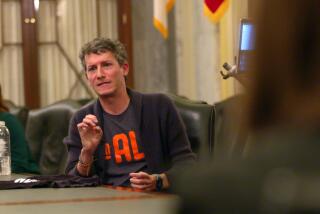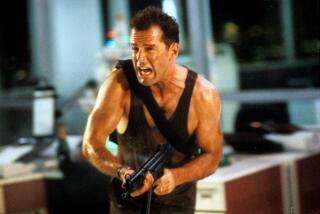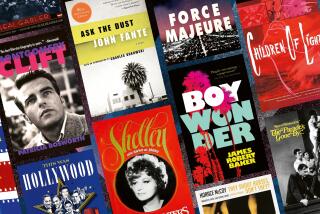Irving Wallace; Prolific Writer Reached Billion Readers
Irving Wallace, the prolific wordsmith whose nearly three dozen books have been read by an estimated 1 billion people, died Friday at Cedars-Sinai Medical Center of pancreatic cancer.
Wallace, the author of “The Chapman Report,” “The Word,” “The Prize” and a storyteller likened by many to W. Somerset Maugham, was 74 when he died at Cedars-Sinai Medical Center where he had been admitted Wednesday. He had been battling the cancer for several months.
Hospital spokesman Ron Wise said Wallace’s wife, Sylvia, son, David, and daughter, Amy, all authors, were at his side when he died at 12:48 p.m.
At his death, Wallace’s books, which he wrote painstakingly on an Underwood typewriter given to him by his parents when he was 13, had sold about 200 million copies, making him one of the best-selling writers of all time.
And nearly all were still in print, for when he wrote a new novel, his publishers reissued many of the older ones in paperback.
He also was one of the best-traveled of modern writers, having journeyed to the jungles of Honduras, to the beaches of Hawaii and to the mountains of Scandinavia for his material, which ranged from the working habits of the President of the United States to the cocktail party conversations of housewives in his Brentwood neighborhood.
He was a disciplined workaholic who wrote only six hours a day yet stayed up much of the night preparing for the following day’s six hours.
“To be quite frank about it,” he said in “The Sunday Gentleman,” a collection of his writings, “I had never not written books. I had written them while hardly out of puberty. I had written them in high school, college, in the Army and in the Sundays of my magazine (writing) years.”
Wallace estimated that in the years from age 17 through 34 alone he had written four unfinished nonfiction books, five full-length nonfiction books and “at least one or two chapters of a half-dozen novels.” None were published.
It wasn’t until “The Chapman Report” in 1960 that Wallace was catapulted from a life of economic travails into a writer the Saturday Review once identified as one of the five most popular living authors in the English-speaking world. (The others were Barbara Cartland, Louis L’Amour, Harold Robbins and Janet Dailey.)
That book, which grew out of his observations of neighbor women, became a controversial best-selling examination of sexual proclivities in the suburbs.
Those royalties supported his sprawling 17-room country-style home in Brentwood (“The Briars” in “Chapman”), a beach house in Malibu and a farm home on the island of Minorca off Barcelona and east of Majorca.
He carved a unique niche for himself in the literary world, examining such familiar subjects as the Nobel Prize and the Bible and making of them convoluted personal dramas, drenched in research and crammed with conflict.
Wallace combined the topical with the mysterious, bringing to each an element of expose that proved perennially popular.
In “Irving Wallace: A Writer’s Profile,” John Leverence wrote that when Wallace begins a book he is “always curious to investigate what psychological motives bring a certain person into his field or profession. Why is a surgeon a surgeon? Why does he enjoy cutting flesh? . . . Why does that woman like to teach, and why does this man like to dig into the earth?”
Much he gleaned from personal observation, for Wallace was a skilled interviewer. “I had a friendly face, and I was a good listener,” he said.
But many critics disdained his writing and his skills, claiming he concocted potboilers of temporal value exalted only for their trendy acceptance.
The New Republic said this of “The Word,” Wallace’s Biblical epic which he based on the fictionalized discovery of a new set of New Testaments:
“The Irving Wallace formula for a bestseller seems to be: put everything in, make a goulash . . . besides the Biblical plot, the novel trafficks in spies, international police, two miracles . . . and a proposed Protestant Vatican. It also has doses of sex, drugs, tragic irony, (and) scholarly hokum.”
Biographer Leverence saw the Wallace oeuvre differently:
“You can’t understand Irving Wallace’s books if you try to relate them to a long tradition of elite, classical American literature. But if you relate them to the traditions of American popular writing, particularly journalism and film writing, then they make sense.”
Leverence’s comments themselves made sense, for it was in the disciplines of magazine journalism and film that Irving Wallace began his lengthy and eminently successful relationship with words.
Born the son of Jewish parents who emigrated from Russia as teen-agers and met and married in the United States, his real name should have been Irving Wallechinsky. But an Ellis Island immigration officer shortened the name. (Years later when Irving’s son, David, heard the story, he changed his name to Wallechinsky.) Thus it was as Irving Wallace that he grew up in Kenosha, Wis., where his parents ran a general store.
Wallace the boy haunted the town library and began writing short stories and articles, the first of which he sold to a magazine for $5 when he was 15. That was all the encouragement he needed. At one point, he said in a 1985 interview with The Times, “I had 50 stories out to publications at the same time and in a single morning’s mail I once received 12 of them back with rejection slips.”
He quit college after only two semesters to become a free-lance writer for magazines while trying to break into film writing.
He received several magazine assignments, among them a movie-star interview for Modern Screen. From that assignment grew not only a story but a marriage. His wife, then Sylvia Kahn, was the West Coast editor for Dell Publications, which owned Modern Screen.
They had been married only six months when World War II broke out and Wallace joined the Air Force, where he ended up in the First Motion Picture Unit. The personnel officer was a young lieutenant named Ronald Reagan. He honed his embryonic screen-writing skills with such wartime documentaries as “Know Your Enemy Japan” and “War Comes to America.”
He returned to free-lance writing after his discharge, and in 1949--based largely on earlier successes interviewing such world celebrities as Pablo Picasso, Alfred Krupp, Polly Adler and W. C. Fields--broke into films with Columbia. Until 1958 he penned screenplays for Columbia, 20th-Century Fox, Universal and Paramount. But a year later he abandoned film writing to devote himself to novels.
Where he had once thought that film scripting would prove satisfying, offering the financial security he had long sought, he discovered that “when I finally landed work in the studios, my only desire was to get out. I hated the act of writing by committee, where individuality is lost to compromise.”
He had begun writing his published book, “The Fabulous Originals” in 1953. It dealt with the people who had inspired some of fiction’s most memorable characters. Among them were William Brodie, Robert Louis Stevenson’s inspiration for “Dr. Jekyll and Mr. Hyde,” and Dr. Joseph Bell, said to be Arthur Conan Doyle’s prototype for Sherlock Holmes. It was published in 1955.
While still in films he also wrote “The Square Pegs,” stories of nine eccentric Americans, and “The Fabulous Showman,” a candid biography of P. T. Barnum.
But it wasn’t until 1960 and “The Chapman Report” that Wallace became the successful novelist of his dreams.
Banned in a few countries because of its erotic nature and explicit language, it was Wallace’s long-envisioned fictionalized account “about the married or once-married young women in our Brentwood neighborhood.”
He had long ago heard the conversations he needed, but lacked a focal point. The popular sex surveys of the day provided that entree.
“I asked myself,” he said in the 1985 interview, “what if a team of male sociologists arrived in my community to make a sex survey and interviewed the women I knew? How would these personal interviews affect the women? And how would the interviews affect members of the sex survey team?”
He superimposed fictional stories on his neighbor women, studied the sexual surveys of the time and from that came the first of the Wallace blockbusters.
Next came “The Twenty-Seventh Wife,” a biography of Brigham Young’s last mate; “The Prize,” an inside look at the Nobel Prize and how they are awarded (long banned in Scandinavia because of its piercing examination of the Nobel selection process); “The Three Sirens,” about a team of American anthropologists studying a tribe of sexually permissive South Sea islanders, and “The Man.”
For that book, published in 1964, Wallace got permission from John F. Kennedy to spend 10 days in the White House. “I wanted to play being President,” said Wallace of this novel about a black legislator who succeeds to the presidency, where he completes an unfinished term.
“The Plot,” a tale of intrigue set in Paris; “The Seven Minutes,” a novel of pornography and censorship, and “The Nympho and Other Maniacs,” a nonfiction biography of scarlet ladies of history, came next. And then Wallace temporarily abandoned sex for a novel many consider his most imaginative.
His inspiration for “The Word” came after he had heard a group of people discussing the discovery of the Dead Sea Scrolls. “I thought: suppose still another discovery is made, another part of the Bible in which Jesus is described more clearly. I pursued that line of imagining and gradually I invented the greatest archeological discovery of all time--the unearthing of the first and original gospel written by James, the younger brother of Jesus, which offers the world a living and relevant Christ--and promises to change the face of the Bible and to reshape mankind.”
“The Word” took 10 years of thought and interviews with 58 Bible experts to bring to the page. A TV miniseries starring David Janssen was broadcast in 1978.
Wallace combined lust and Hollywood luminaries in “The Fan Club,” a sordid suspense novel in which a movie star is kidnaped by a group of working men who have made her the object of their sexual fantasies. They justify the action by saying only “fat cats” ever get what they want in life, a theme he began to expand upon after hearing some railroad workers discussing what they would give to spend a single evening with Elizabeth Taylor.
Wallace stepped up his fictional output in the 1980s with “The Almighty,” “The Miracle,” “The Seventh Secret,” “The Celestial Bed” and “The Guest of Honor,” although none attracted the international acceptance of his earlier works.
He also wrote what he called “our family books”--”The People’s Almanac” series and “The People’s Almanac Presents the Book of Lists.” Those began “with my son,” he wrote for the “Contemporary Authors Autobiography Series.”
“From the age of 8 David had always been an almanac buff. Then one day in 1971 he began to question the infallibility of the almanacs and other reference books he had been reading.”
The Wallaces--including wife and daughter Amy--tried to clarify what they felt were distortions of history and current events in those other publications which Wallace la pere also pronounced “incredibly dull.” One contributor to what has come to be known popularly as “The Book of Lists” was Peanuts creator Charles Schulz, who wrote a chapter on Snoopy.
Eleven of Irving Wallace’s books have been sold to motion pictures, the medium he once decried as confining, while four have found their way to television. He has increased his audiences further with articles in The Encyclopedia Britannica, American Oxford Encyclopedia and Collier’s Encyclopedia.
A major portion of his manuscripts have been donated to the Honnold Library at the Claremont Colleges.
Until shortly before his health failed, Wallace continued to travel the world, annually to Europe, periodically to locales that might become subjects of future novels for the still-productive listener and interviewer.
“I love to tell stories,” he told The Times’ Marshall Berges. “ . . . To create people and worlds half real, half imaginary. Even if I could not earn a penny from my writing, I would earn my livelihood at something else and continue to write at night.”
Funeral services will be private. A memorial service has been scheduled for 1 p.m. Thursday at the Directors Guild of America.
The family has requested that any memorial contributions be made to the Amie Karen Fund for Cancer Research, Cedars-Sinai Medical Center, or to PEN (Poets, Playwrights, Essayists, Editors and Novelists) American Center, 568 Broadway, New York, N.Y. 10012.
More to Read
Sign up for our Book Club newsletter
Get the latest news, events and more from the Los Angeles Times Book Club, and help us get L.A. reading and talking.
You may occasionally receive promotional content from the Los Angeles Times.









